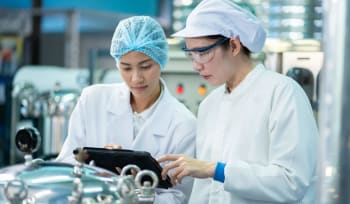Time, Action, Concentration and Temperature Considerations for Cleaning Membranes used in Food and Beverage Processing Equipment
This informal CPD article was provided by Diversey, who offer training courses for food and beverage processing professionals.
Membranes are often made of very thin layers of plastic measuring less than the thickness of a sheet of paper. Care needs to be taken during cleaning to avoid damage such as stress-cracking the polymeric membrane layer or modifying the surface permeability.
Successful membrane cleaning relies on the effectiveness of the cleaning compounds as well as their application. When designing membrane cleaning guidelines, the principles of TACT (time, action, chemical, temperature) should be followed and parameters adjusted to meet specific requirements.
Time
Time strategies can be used when cleaning membranes as it is one of the parameters that can be easily changed. For example, wash solutions can be left in contact longer or wash steps repeated several times to gradually remove a soil. You can also switch back and forth from acid type cleans to alkaline or enzymatic cleans. Membrane cleaning procedures will typically take upwards of 4 hours to complete.
Action
When cleaning membrane systems, the flow across the membranes is determined by the stage or cross-flow pump. The mechanical action cannot change without changing the pumps. Please follow the pump manufacturer’s recommendations.
Chemical Concentration
The type and concentration of chemicals that can be used to clean membranes is limited. The product and concentration will be determined by the materials used in the membrane and the manufacturer recommendations. It is critical to know what type of membrane is being cleaned to ensure the correct procedure is being used.
Typically, when faced with a difficult cleaning problem, our first thought is to increase the caustic concentration to 2-3%. High caustic is not an option for membranes cleaning due to the limits placed on pH by membrane elements manufacturers.
Defoamers should never be used when cleaning membranes or used with products being processed through membranes. Almost all defoamers will stick to polymeric membranes causing them to foul and not permeate. It is also extremely difficult to remove defoamers from a membrane surface.
Thin Film Composite (TFC) membranes are made with a very thin layer of polyamide laid over a polysulfone membrane. While chlorine is used to clean polysulfone membranes all the time, polyamide cannot tolerate chlorine, even at very low levels. In this instance, enzyme cleaners are the only option to remove protein from a TFC reverse osmosis membrane.
Most of the membranes used in dairy applications are made of plastics. Plastic presents many challenges when it comes to cleaning: surfactants may induce stress-cracking and solvent-type cleaners can dissolve the glues used to hold membranes together. Most plastic membranes can tolerate a pH in the range of 1-12, but it is recommended to stay within a pH of 1.8 – 11.5.
When confusion exists around selecting the appropriate cleaning chemistry, it is recommended to consult with both the membrane manufacturer and a reputable cleaning company.
Temperature
Temperature can be very limiting when cleaning membranes. Polymeric or plastic membranes are generally limited to 135°F (57°C) and most element manufacturers recommend a cleaning temperature at or below 125°F (50°C).
The removal of fats and oils from a membrane is also impacted by temperature. To saponify fats with caustic you need temperature above 150°F (65°C) but polymeric membranes cannot tolerate temperatures this high. A limited amount of caustic with a buffered pH, combined with the right surfactants, will help removing fatty residues.
Surfactants are used to remove fats and oils from membranes due to their ionization behaviour. When added to water, surfactants ionize and have a specific charge adhering to the fats and oils and enable them to dissolve in water. However, if foaming is seen during membrane cleaning, it is as a result of the surfactants lowering the surface tension. The selection of the right non-ionic surfactant in the formulation will help lower the surface tension and also reduce foam creation.
We hope this article was helpful. For more information from Diversey, please visit their CPD Member Directory page. Alternatively please visit the CPD Industry Hubs for more CPD articles, courses and events relevant to your Continuing Professional Development requirements.













